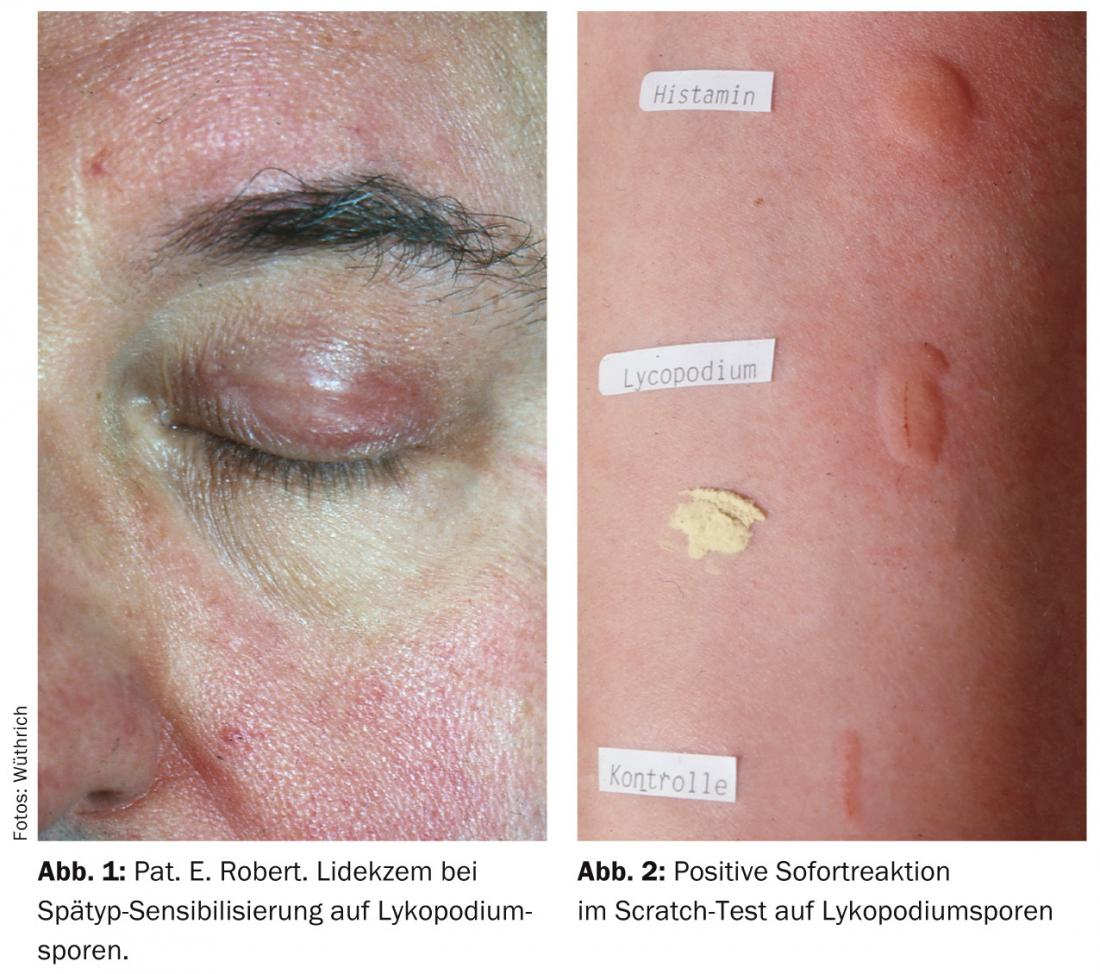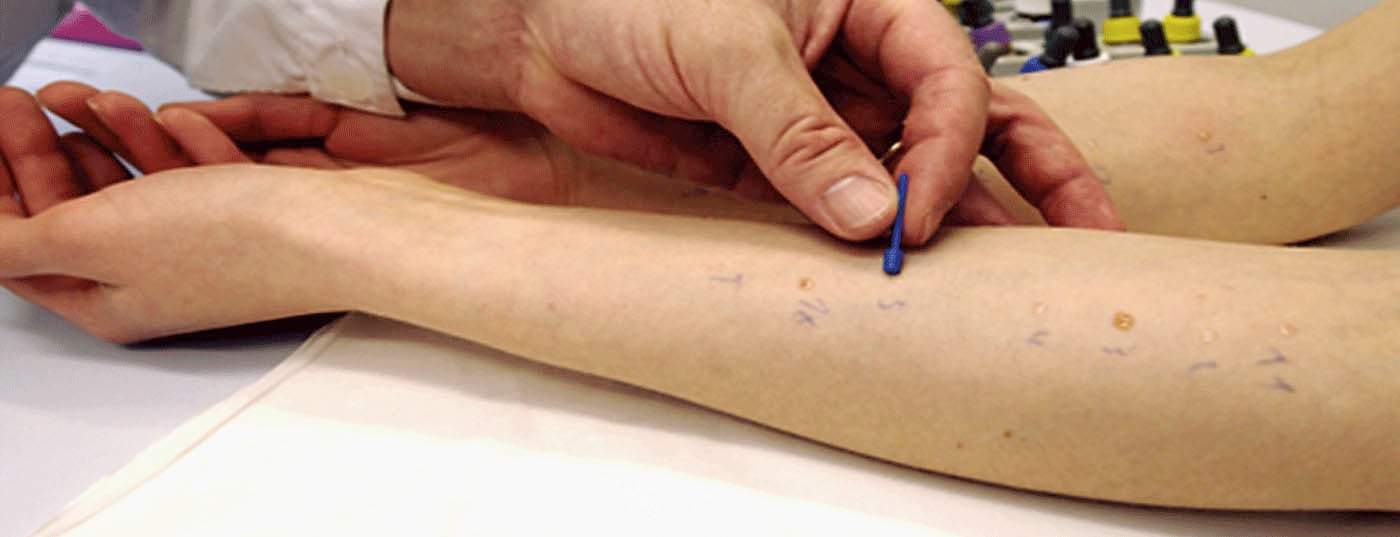Case history: The 57-year-old lighting designer and head of lighting at the Zurich Schauspielhaus suffered from sporadic asthma attacks at work during the last years without any apparent cause. Sneezing fits and coughing occurred during vacuuming at home and contact with cats. There was also an increased incidence of eyelid eczema.
Allergological clarification
- Prick skin tests with inhalation allergens of the standard series at the allergy ward of the University Hospital Zurich showed positive immediate reactions to the house dust mites Dermatophagoides pteronyssinus and Dermatophagoides farinae, to cat epithelium as well as to grass, rye and mugwort pollen. A scratch test of house dust samples from the home and stage was negative.
- Specific IgE (RAST/CAP) to house dust mites D. pteronyssinus and D. farinae 4.4 and 4.2 kU/l (CAP class 3), respectively.
- Lung function at the lower normal limit (FEV1 80% of target value). Bronchospasmolysis test negative.
Course
Assuming that the asthma was caused by the dust mites despite negative scratch tests with self-dust, and since no facial eczema (DD atopic eyelid eczema) was present at the present examination, epicutaneous testing with contact allergens was not performed.
After the main rehearsal of Mephisto, a piece by Ariane Mnouchkine, in which lighting effects were increasingly used, an acute asthma attack occurred and the chief lighting technician had to be taken to hospital as an emergency. As a result, he experienced eye irritation, sneezing fits and coughing as soon as he entered the stage, and asthma of threatening proportions (FEV1 drop to 28% of the target value) during a longer stay. The following day, there was an episode of eyelid eczema (Fig. 1).
Allergological clarification
When presented again at the allergy ward, the patient stated that when Mephisto appeared on stage, explosion-like light effects were produced by using the spores of the plant Lycopodium clavatum (club mace).
The subsequently performed scratch test with Lycopodium powder was positive (Fig. 2).

An epicutaneous test with Lycopodium, with and without attrition (Figs. 3A and 3B), was also positive at 72 hours, but the attrition test for the NaCl control and for rye, mugwort, and grass pollen was not (Fig. 3A) . Both tests were negative in control subjects.

To a nasal provocation test with Lycopodium spore insufflation, the patient reacted with violent sneezing attacks, rhinorrhea and conjunctivitis. Specific IgE to Lycopodium were CAP class 3 (5.2 kU/l) positive.
Diagnosis
Bronchial asthma allergicum in immediate-type and eyelid eczema in late-type sensitization to lycopodium spores in pre-existing dust mite and cat allergy.
Comment
Club mace (Lycopodium clavatum), also called wolf’s claw, is one of the vascular spore plants. The name is composed of Greek lycos (wolf) and pos (foot), probably because the densely leafed branches remotely resemble an animal foot. Latin clavatum (club) refers to the shape of the spore stands (Figs. 4 and 5).

Lycopodium is a creeping plant that grows max. 15 cm high. Since it is richly branched and curls along the ground, it has also received the popular name “snake moss”. The spores mature in July and August and are obtained by tapping out the spore stands. The spores contain about 50% essential oil, 20% sporonine, hydrocaffeic acid, sucrose and alkaloids in traces. Airborne Lycopodium spores are explosive.
The spores of Lycopodium have the biological property of being non-wettable and therefore do not absorb liquid. The druids who lit the sacred solar fires could summon the fire by creating bright flashes and stabbing flames. For this spell they used the spore dust of the lycopod. It got its name “witch dust” from the Christian clergy, to whom this dust was sinister. But to the Celts this plant was sacred, and so Pliny wrote of its special gathering ritual: “It was invoked by the druids barefoot, dressed in unhemmed white robes, on a new moon night, bread and mead (honey wine) offered, and then picked with the left hand.”

In the past, lycopodium spores were used in pharmacies as a separating agent in the production of pills. As well as used as a wound and glove powder. Cases of postoperative granulomas have been described in which Lycopodium spores (from the gloves) have been detected. Depending on the brand, nowadays the smooth-feeling powder is still used to coat condoms (Casuistry 1) [1]. Sex offenders have been wearing condoms more frequently in recent years, so detection of lycopodium spores in victims of sexual offenses can clarify whether the offender was wearing a condom.
Today, lycopodium spores are mainly used in fireworks, jugglers (fire breathing) and in special effects in movies and in theaters to create fireballs, flame columns, stab flames and explosions. “Spitting” (= atomizing) the spores against a flame produces enormous fireballs (Casuistry 2) [2].

In criminalistics, the spore powder was used together with carnin to visualize fingerprints (dactyloscopy).
Lycopodium and holistic medicine
Lycopodium, along with horsetail and ferns, is one of the oldest known plants. From its original giant size, it has shrunk to the size of a small moss – this in advance to understand what holistic medicine means by a “lobe condition”. In such a one are people who, despite abilities, feel themselves to be small and inferior. Out of this feeling of inferiority, they think – so the teaching goes – that they have to bloat, and often suffer from intestinal flatulence. In eczema, Lycopodium is considered the right remedy in homeopathy if the skin symptoms started on the right side of the body, because this “remedy” always emphasizes the right side of the body.
Finally, as a constitutional remedy in homeopathy, Lycopodium is still used as a mother tincture and in various potencies for diseases of the urinary, genital, digestive and respiratory organs.
Literature:
- Rask-Andersen J, et al: Asthma, skin symptoms, and allergy in a condom factory. Allergy 2000; 55: 836-841.
- Morresi-Hauf A, et al: Granulomatous bronchiolitis after aspiration of Lycopodium spores in a fire breather. Pneumology 2009; 63(2): 67-71. DOI: 10.1055/s-2008-1038256.
DERMATOLOGIE PRAXIS 2014; 24(6): 28-30
DERMATOLOGIE PRAXIS 2018 Special Edition (Anniversary Issue), Prof. Brunello Wüthrich












